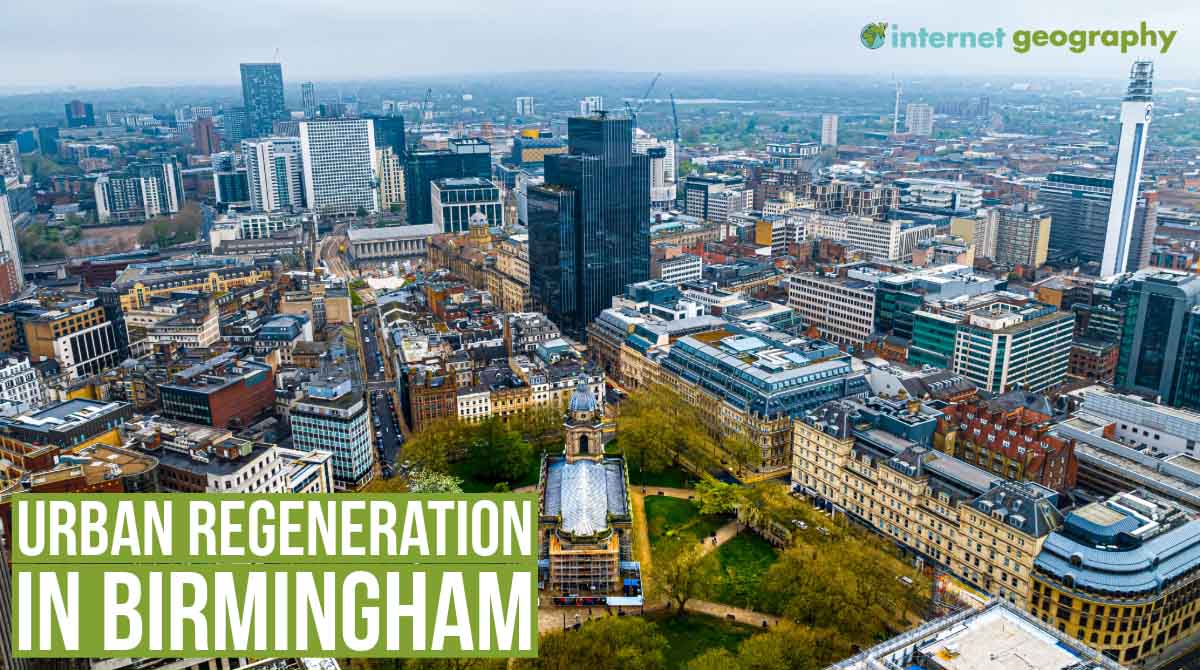Eastside and HS2 Curzon Street
Location and Characteristics Before Redevelopment
Eastside is located just east of Birmingham city centre, near Digbeth and Birmingham Moor Street station. The area was historically a hub for manufacturing and industry, but it had become severely run-down by the late 20th century. Before redevelopment:
- It featured large areas of derelict brownfield land.
- Industrial buildings and warehouses were abandoned or underused.
- The area lacked green spaces and had poor pedestrian access.
- Economic activity was low, and the area was disconnected from the city core.
Reasons for Regeneration
- Industrial decline: The collapse of manufacturing left behind derelict infrastructure and declining employment.
- Poor urban environment: Outdated buildings and poor-quality public realm limited economic and social activity.
- Transport potential: Plans for the High Speed 2 (HS2) rail link positioned Eastside as a strategic location for redevelopment.
- The need for investment in education and business space was identified as part of the city’s vision for a knowledge economy.
Main Features of the Project
- HS2 Curzon Street Station: A new high-speed rail terminal linking Birmingham to London in under 50 minutes. The station is designed to be a significant national transport hub.
- Eastside City Park: The first new city park in Birmingham in over 130 years, providing green space and improving the area’s visual appeal.
- Expansion of Birmingham City University’s campus: Modern facilities for students, encouraging knowledge-based industries and urban vibrancy.
- Enterprise and Innovation Zones: Support for digital, creative, and tech businesses, creating new jobs and investment opportunities.
- Public realm improvements: Better pedestrian routes, cycling paths, and integration with the wider city centre.
Following regeneration, Eastside is increasingly known as Birmingham’s Education Quarter. The area has undergone significant transformation to support a thriving academic environment, with a focus on creating a cohesive ‘campus feel’ centred around Aston University. It is also home to Birmingham City University’s City Centre Campus, Birmingham Metropolitan College, and the Birmingham Conservatoire, making it a hub for higher education. The development features new teaching facilities, student accommodation, and enhanced public spaces designed to foster collaboration and innovation. Eastside is also home to the Thinktank Science Museum at Millennium Point, a major educational and visitor attraction that enhances the area’s identity as a centre of learning and discovery.
| Feature | Eastside Regeneration |
|---|---|
| Location | Inner city, east of Birmingham city centre (near Digbeth) |
| Reason for decline | Industrial decline – derelict factories and underused land |
| Main focus | Education, innovation, green space, student housing, and HS2 terminal |
| Investment | £6–8 billion regeneration including HS2 and Eastside City Park |
| Key developments | HS2 Curzon Street Station, Eastside City Park, Birmingham City University expansion |
| Jobs created | 12,000 permanent and 8,000 construction jobs (estimated) |
| Housing | New student accommodation and housing as part of mixed-use development |
| Green space | Eastside City Park – first major new park in 130+ years |
| Transport links | Near Moor Street station, planned HS2, walking routes improved |
| Positive impacts | Economic growth, better environment, attraction of students and investment |
| Challenges | Risk of gentrification, traffic pressure, rising land values |
Summary
Flashcards
Quiz
Perry Barr Regeneration and the Commonwealth Games
Location and Characteristics Before Redevelopment
Perry Barr lies 4 miles north-west of Birmingham city centre, with key transport links via the A34 and Perry Barr railway station. Before redevelopment:
- The area suffered from deprivation, high unemployment, and poor health outcomes.
- Housing stock included outdated and poor-quality post-war developments.
- Public infrastructure and transport were under-invested.
- The area had a weak local economy and limited amenities.
Reasons for Regeneration
- Socio-economic challenges: Long-term deprivation and low investment made the area a priority for improvement.
- Sporting legacy opportunity: The 2022 Commonwealth Games acted as a catalyst for regeneration.
- Housing shortage: The city needed more homes, particularly affordable housing, and Perry Barr had available space for development.
- Transport limitations: Existing infrastructure was outdated and congested.
Main Features of the Project
- Perry Barr Residential Scheme: Over 1,400 new homes were built on the site of the former Birmingham City University campus, with a focus on affordability and sustainability.
- Alexander Stadium redevelopment: Upgraded to host the Commonwealth Games and now a regional athletics centre, boosting local sport and leisure.
- Transport improvements: Revamped Perry Barr railway station, improved roads, new bus routes, and better cycling infrastructure.
- New public spaces: Creation of open spaces and landscaping to enhance the urban environment and community facilities.
- Economic stimulus: The regeneration created jobs during and after the Games, boosted local pride, and attracted inward investment.
| Feature | Perry Barr Regeneration |
|---|---|
| Location | North-west Birmingham, around the A34 and Alexander Stadium |
| Reason for decline | Long-term deprivation, outdated housing, and poor transport links |
| Main focus | Housing, sport and leisure, transport, and public space improvements |
| Investment | £700 million+ linked to 2022 Commonwealth Games and future housing investment |
| Key developments | 1,400+ new homes, Alexander Stadium upgrade, new Perry Barr rail station |
| Jobs created | Jobs in construction, sport, retail, and public services linked to Games and housing growth |
| Housing | Mix of private and affordable homes in major residential scheme |
| Green space | New landscaped public areas, parks near housing and stadium |
| Transport links | Upgraded rail station, better bus and cycle routes, improved roads |
| Positive impacts | Better housing, improved image, community pride, sporting legacy |
| Challenges | Long-term affordability, integration with surrounding areas, construction disruption |

